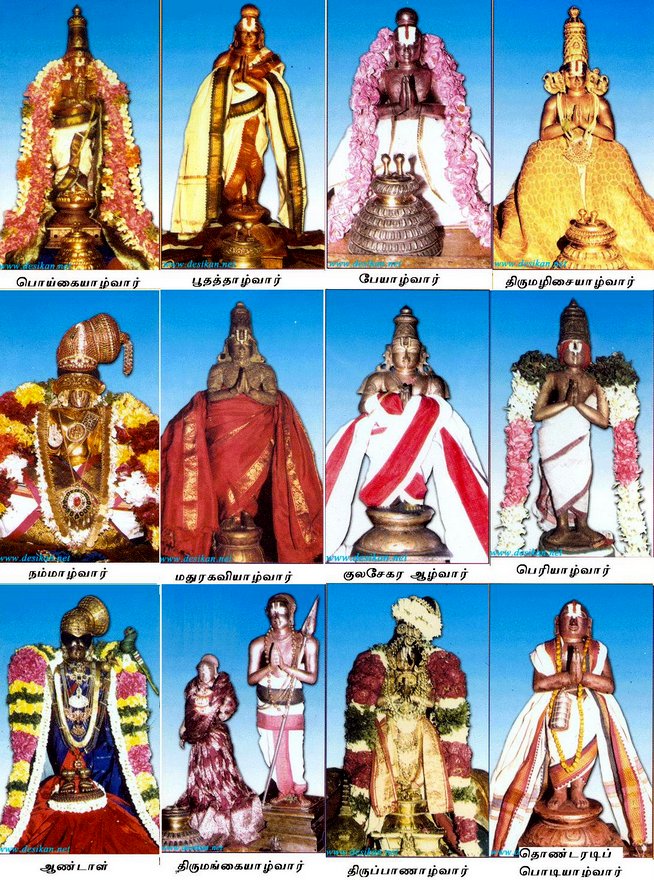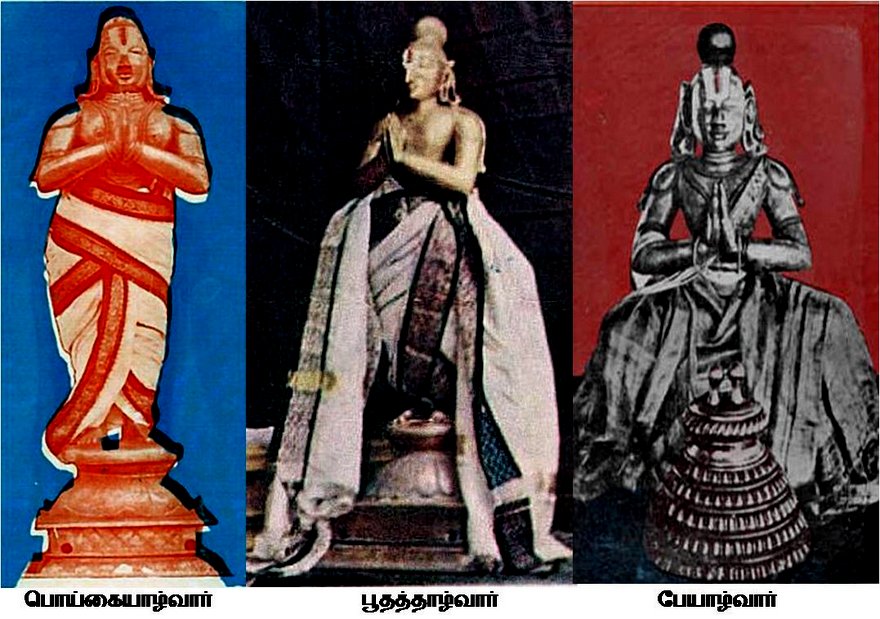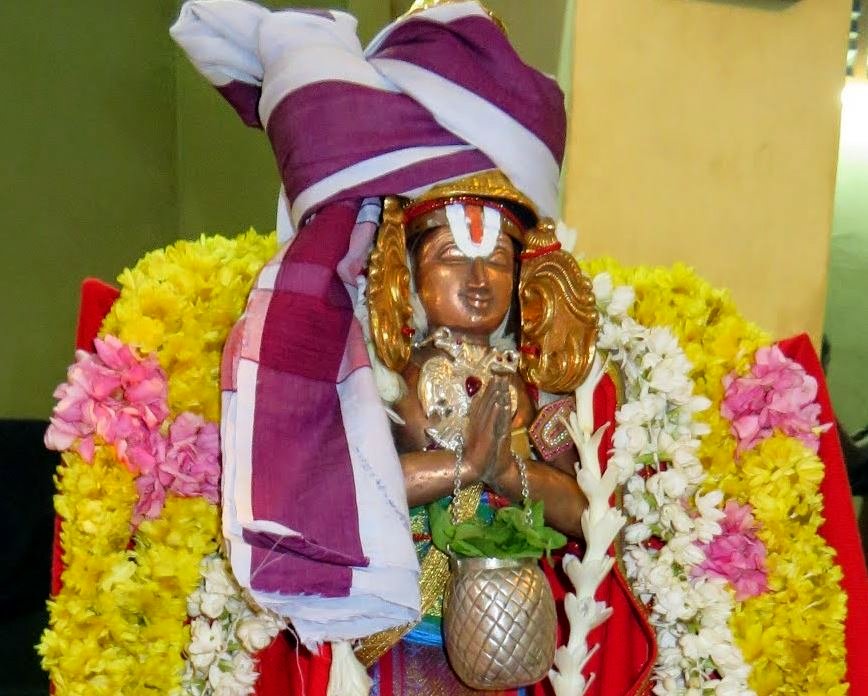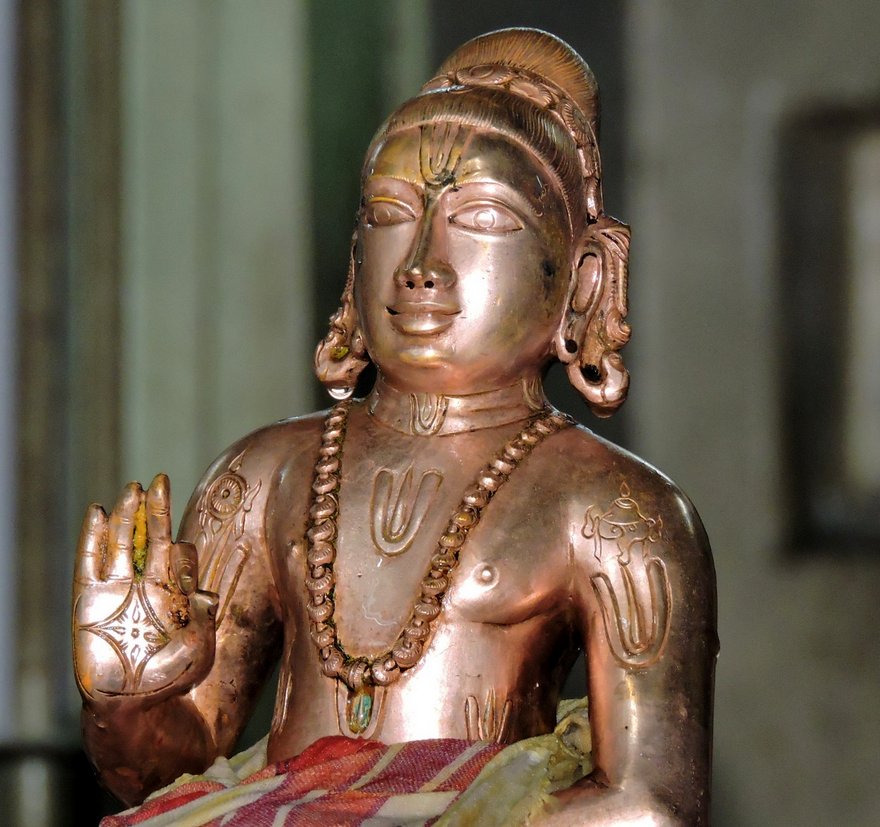Azhwars (or Alvar) are the Vaishnavite saints who had composed a collection of 4000 hymns, called Nalayira Divya Prabhandham (4000 divine verses) in praise of Lord Vishnu and His many avatars.
These verses are called “Dravida Veda” that is Vedas in the Tamil language! The word Azhwar, in Tamil, means “one who is immersed”. Since the azhwars were immersed in their devotion and love for the Lord, they were called so.The azhwars are twelve in number: 11 men and 1 woman, and they belonged to various castes, by birth. The only common thread amongst them all was their unwavering devotion to Lord Vishnu.
The traditional view of the beginning of the timeline for the azhwars has been from the end of Dvapara yuga. The first three azhwars are said to have been born at the end of Dvapara yuga, just after Krishna departed from this earth.
1. Poigai Azhwar:
Considered as the first of the 12 azhwars, poigai azhwar was found in a pond (Poigai in Tamil) in the Yadhothakaari temple in Kanchipuram (near Chennai), hence he is called Poigai Azhwar. He is believed to have been born as an incarnation of Lord Vishnu’s conch, Panchajanya. He composed 100 songs in praise of the Lord.
2. Bhoothath Azhwar:
Bhoothathazhwar was found in a liquorice flower (Athimathuram in Tamil) in a pond at the Kadalmallai temple (at present Mahabalipuram near Chennai). Bhootham means one who is possessed. Since this azhwar was so possessed by his devotion to the Lord, he was called Bhoothathazhwar. He is believed to have been born as an incarnation of Lord Vishnu’s mace Kaumodakee. He composed 100 songs in praise of the Lord.
3. Peyazhwar Azhwar:
Peyazhwar was born in Mylai (at present Mylapore in Chennai). He was found in a lily (Alli) flower in the pond of Sri AdiKesava Perumal temple. Like bhoothathazhwar, the name “Peyazhwar” also signifies one who was possessed by Lord’s devotion. Peyazhwar also composed 100 hymns in praise of the Lord.
4. Thirumazhisai Azhwar:
Thirumazhisai Azhwar was born to a saint named Bharghava Muni. He is considered to be an incarnation of Lord’s discus Sudharshana Chakra. Since at birth, Thirumazhisai azhwar’s body was incomplete without any of the limbs, the parents left the baby at a nearby ditch. The Lord and His Consort appeared before the baby and blessed him with a complete body. He was then adopted by another person.
The adoptive mother then gave birth to another boy, named KaniKannan, who became an ardent disciple of Thirumazhisai Azhwar. Once the king ordered KaniKannan to leave the country as he refused to sing the praise of the King, citing his vow that he, just like his guru, will only sing the praise of the Lord. When KaniKannan readied to leave the country, Thirumazhisai Azhwar also left the country along with him. On their way out, they went to the Yadhothakari temple and told the Lord also to come along with them. The Lord rolled his mat (Adhisesha) and left along as well.
The King then repented for his mistake and requested them all to come back in his country. All three of them then returned to their original abode. Thirumazhisai Azhwar learnt Buddhism and Jainism as well. He became an ardent devote of Lord Shiva. Once he saw an old man who was planting a tree upside down. Upon inquiry, the old man said this is not more foolish than Thirumazhisai azhwar’s devotion to Shiva in search of Moksha as only Narayana can grant Moksha.
Azhwar then got this verified by Lord Shiva himself that the only Lord Narayana can grant Moksha. The person who changed azhwar’s mind to become a vaishnavite was none other than Peyazhwar. Thirumazhisai azhwar has sung 216 hymns in praise of the Lord.
5. Thirumangai Azhwar:
Thirumangai Azhwar was born in ThirukKuraiyaloor village, to a Chola chieftan, as an incarnation of Lord’s divine bow the Saaranga. Thirumangai azhwar was named Neelan and was brought up as a brave prince, who eventually became the king of “Thirumangai” country. When he sought the hands of Kumuda Valli for marriage, she put forth two conditions:
1. 1008 devotees of Vishnu will have to be fed by them everyday.
2. Their feet would be washed with water and that water will be sprinkled on Neelan and herself.
The king agreed to both the conditions and happily married Kumuda. Feeding 1008 people on a daily basis took its toll on Neelan’s finances, hence he became poor and couldn’t pay the taxes to the Chola king. To continue the service of feeding the devotees, Neelan took to mugging and theft. Once he tried to take away the jewels of a newly married couple, he faced a physical challenge in removing the groom’s ring from his finger.
While trying to remove the ring, Neelan asked the groom if he had some magical power to hold the ring back. The groom (who was actually Lord Narayana) told him the meaning of “Ashtakshara Mantra” the supreme 8 letter mantra of Om Namo Narayanaya. On hearing this and on touching the Lord’s feet for removing the ring, Neelan’s mind gets corrected and he starts praising the Lord and His Consort Lakshmi. The Lord then told him to go to all temples and sing in praise of the Lord.
6. Thondaradipodi Azhwar:
Thondaradipodi was born in a village named “Thiru mandaggudi” near Tanjore, Tamil Nadu, as an incarnation of Vishnu’s garland Vanamaala. He was born to a brahmin parents who named him “Vipra Narayanar”. He used to be so engrossed in his love for the Lord that he never paid any worldly attention to women.
Once two sisters who were dancers at the King’s court were passing through Vipra Narayanar’s garden while the latter did not even notice these beautiful ladies near him. The younger sister then vowed to gain his attention and his love. She faked her identity as a desolate woman and gained his confidence and trust. Eventually Vipra Narayana will fall in love with this dancer. She began to love him sincerely as well.
However, her mom was money minded and asked Vipra Narayana to gift her expensive ornaments/silverware in return for her daughter’s hand. Vipra Narayana returned to his hermitage with disappointment. The Lord decided to play a divine game here. He disguised Himself as a disciple of Vipra Narayana and went to the dancer’s mom with a huge silver vessel, claiming to have been sent by Vipra Narayana himself.
The next morning, the temple archakas found the temple’s silver vessel missing and traced it to the dancer’s mom who then pointed at Vipra Narayana as her source of the vessel. Before the King could punish them, the Lord appeared in the King’s dreams and explained the situation. The King then sent back Vipra Narayana with utmost respect.
Vipra Narayana spent the rest of his life as an ardent devotee of Lord Vishnu. Vipra Narayana considered himself as lowly than the dust particle of a Vishnu’s devotee, hence the name Thondaradi podi azhwar. Thondar = devotee, adi = feet/sand on the feet, podi = small/lowly.
7. Thiruppaan Azhwar:
Thiruppaan azhwar was born in the Paanar (musician) caste in a village called Uraiyoor near Sri Rangam, as an incarnation of Srivatsa the mole on Lord Vishnu’s chest.
Due to the erstwhile restrictions on people of certain castes, the Paanar people were not allowed to touch the Cauvery water or to visit the Sri Rangam shrine. So Thiruppaan azhwar used to stand across the other bank of the Cauvery river and sing praises on Sri Ranganatha. Once Sri Ranganatha came in the dreams of a devout Brahmin Loka Saaranga Maha Muni, who used to bring Cauvery water for Lord’s Holy bath, and asked him to carry Thiruppaan azhwar on his shoulders the next day.
Despite huge protest by Thiruppaan azhwar, Saaranga Muni forced him to get on to his shoulders and carried him to the Sri Ranganatha Swamy temple. The world got to know the intent of the Lord (that caste doesn’t matter when it comes to devotion and attaining Lord’s affection).
8. Periyazhwar:
Periyazhwar was born in SriVilliputthur in Tamilnadu, as an incarnation of Garuda, Lord Vishnu’s vehicle. He was raised with great stories from Krishna Avatara and other avataras.
Once the King of Madurai had a doubt regarding his next life “if he wanted to have a good next life, what should he be doing about it?”
He announced huge prize money for someone who could give him a satisfactory answer. Lord Vishnu came in Periyazhwar’s dreams and asked him to go to the King the next day. Periyazhwar went to the King and explained how surrendering one’s ego, wealth and anger and show dedicated devotion to the Lord will fetch salvation. The King was overjoyed on hearing this response and gave the prize money to Periyazhwar and also named him “Pattarpiraan”.
Periyazhwar dedicated the money to Lord Narayana and continued his garland service to the Lord.
9. Sri Andal:
Andal was the adoptive daughter of Periyazhwar. Lord Vishnu’s consort Bhoo devi incarnated as Andal.
She was found near a Tulsi plant while Periyazhwar was tending to his garden. Her childhood was filled with stories of Krishna’s mischief, childly play and also divine powers. Periyazhwar used to make a garland for the Lord everyday. Andal used to wear it on herself, check in the mirror as if talking to Krishna and then send it with Periyazhwar all this was happening without Periyazhwar’s notice.
Once Periyazhwar came to know of this act of his child, he begged the Lord to forgive both of them and that he would bring a fresh garland then and there. The Lord however refused to wear the garland not worn by Andal! Such was the Lord’s affection towards this child! By the time Andal grew up, she had determined to get married to the Lord only. She sung verses by dreaming up her marriage with the Lord. She did a “Paavai” ritual during the month of Margashirsha getting up very early in the morning, gathering all her friends (pretending to be gopikas!), go to the river and pray to the Lord.
Each day she sung hymns to wake her friends up and in praise of the Lord. The collection of those 30 hymns are known world over as Thiruppaavai. At the end of the paavai ritual, Lord Ranganatha came in the dreams of Periyazhwar and asked him to bring Andal to his temple the next morning. Andal went with Periyazhwar to the temple and the Lord accepted her as His own wife!
10. Nammazhwar:
Nammazhwar was born as incarnation of Vishwaksena (Vishnu’s commander), in the Vellala tribe of Thirunelveli.
As a child, Nammazhwar never ate or spoke or even opened his eyes. His distraught parents left him near a temple. He crawled by himself and sat under a tamarind tree, where he would sit and meditate for 16 years. He was finally made to speak and made to lecture on dharma sashtras by MadhuraKavi azhwar, who became his disciple. Nammazhwar was named so, by Lord Ranganatha himself who called him “Namm Azhwar” meaning “my devotee”!
After the life of Nammazhwar, for 100s of years, Sri Vaishnavism went into a decline, eclipsed by Buddhism, Jainism etc. It was Nammazhwar who handed over the 4000 hymns of Divya Prabhandham to NadhaMuni whose disciples/lineage until Sri Ramanuja would later spread the divine hymns to the world.
11. Madhurakavi Azhwar:
Madhura kavi azhwar was born as incarnation of Garuda, Vishnu’s vehicle, in a village called Thirukkolur. Madhurakavi azhwar is different from the remaining azhwars that while other azhwars held on to Lord Vishnu as their only way to salvation and praised Him in their songs, Madhurakavi azhwar always held on to his Guru Nammazhwar as his only way to salvation and praised him in the songs!
Madhurakavi azhwar was once visiting Ayodhya temple and he suddenly saw a bright light across the sky. He kept following that light until he found the source of the light under the Tamarind tree (the place where Nammazhwar was seated), as mentioned above. He would then ask Nammazhwar questions on philosophies and devotion, and eventually become the disciple of Nammazhwar himself.
12. Kulasekara Azhwar:
Kulasekara azhwar was born as incarnation of Kaustubha, Lord Vishnu’s chest jewel. Kulasekara azhwar was born to the Chera King and was brought up with warrior training as in any other prince of the time. However, he was also a great devotee of Lord Vishnu.
Once he heard the story of Sri Rama from an old saint and asked his warriors to get ready for a war with Raavana! Once the saint told him that the war is over and Sri Rama won the war singlehandedly, Kulasekara azhwar asked his warriors to get back to their places. The ministers were not happy with this behaviour of their king who would easily be carried away by Vishnu devotees. Hence they devised a plan and stole Lord Vishnu’s jewels and put the blame of the devotees.
Kulasekara azhwar, unable to believe their story, asked for a pot of snakes to be brought. He announced to his ministers that he would be putting his hand in to the pot. If the jewels were indeed stolen by devotees, let the snakes bite him. If not, he will escape without getting hurt. Kulasekara azhwar put his hand into the pot and came out unhurt. His ministers then accepted the truth and begged forgiveness from the King and from the devotees as well. Kulasekara azhwar remained a faithful devotee to the Lord for his lifetime.
Let us all pray for the Azhwars’ blessings to fall upon us.
The post Azhwars: The Mystic Vaishnavite Saints of the South India appeared first on IndiaDivine.org.



